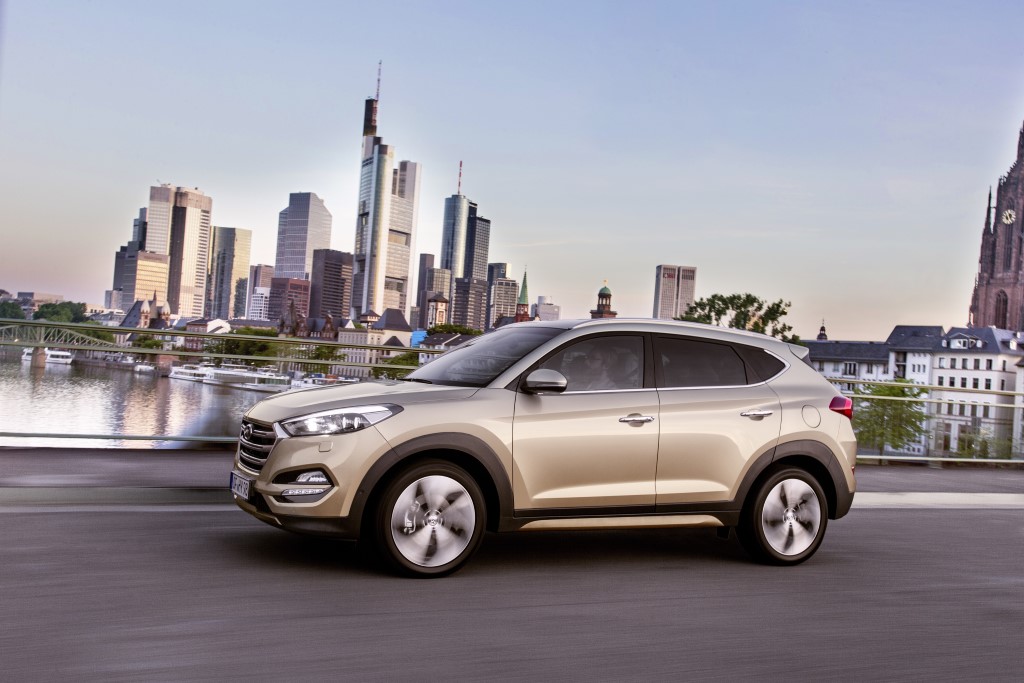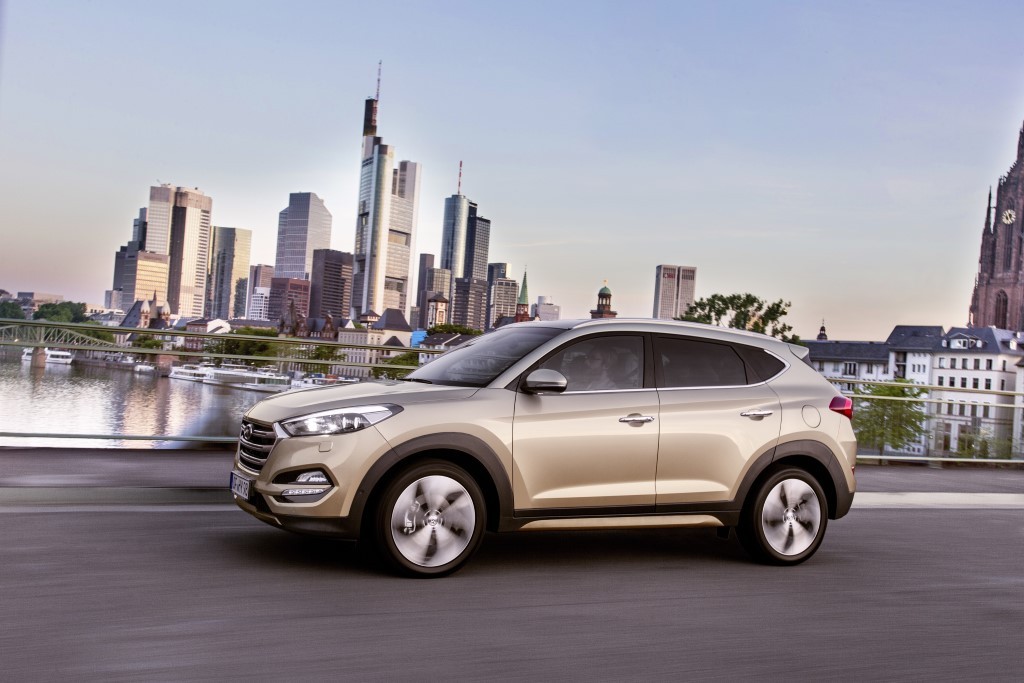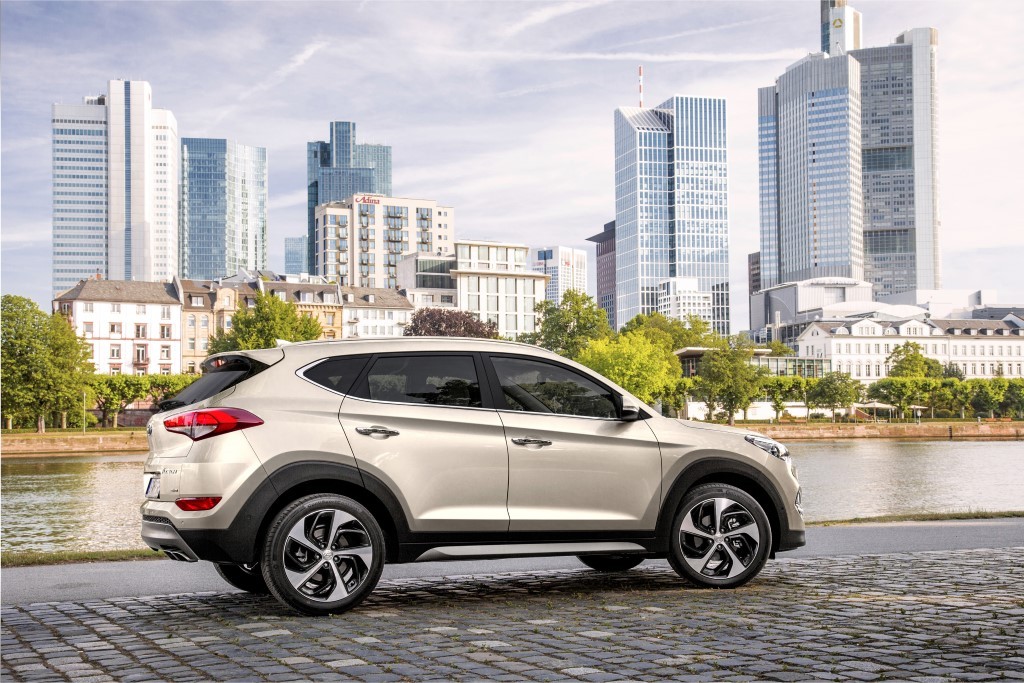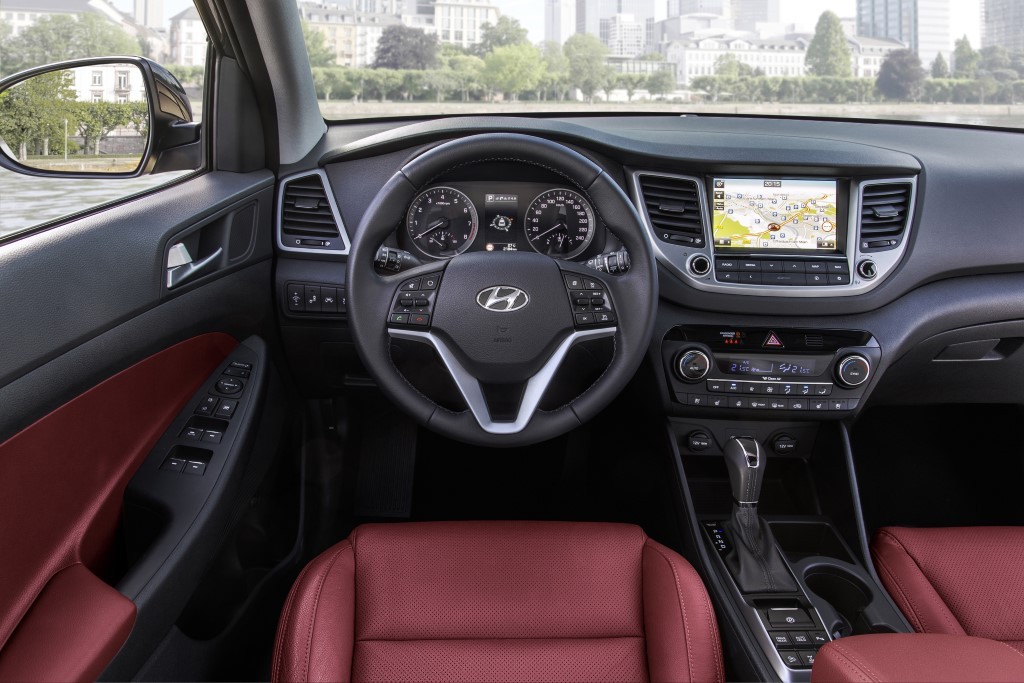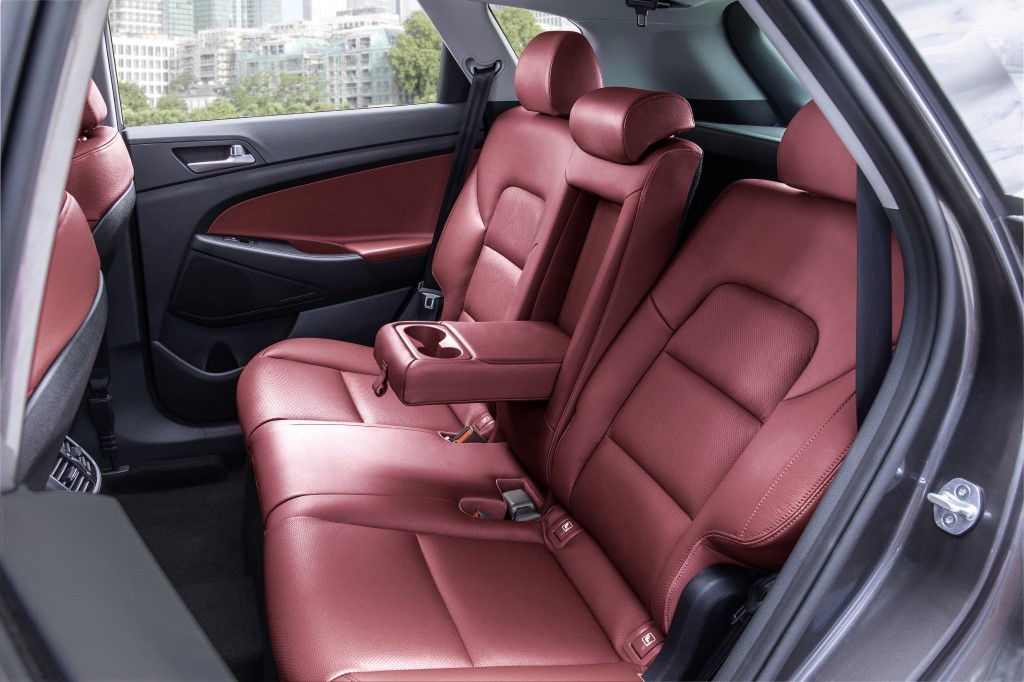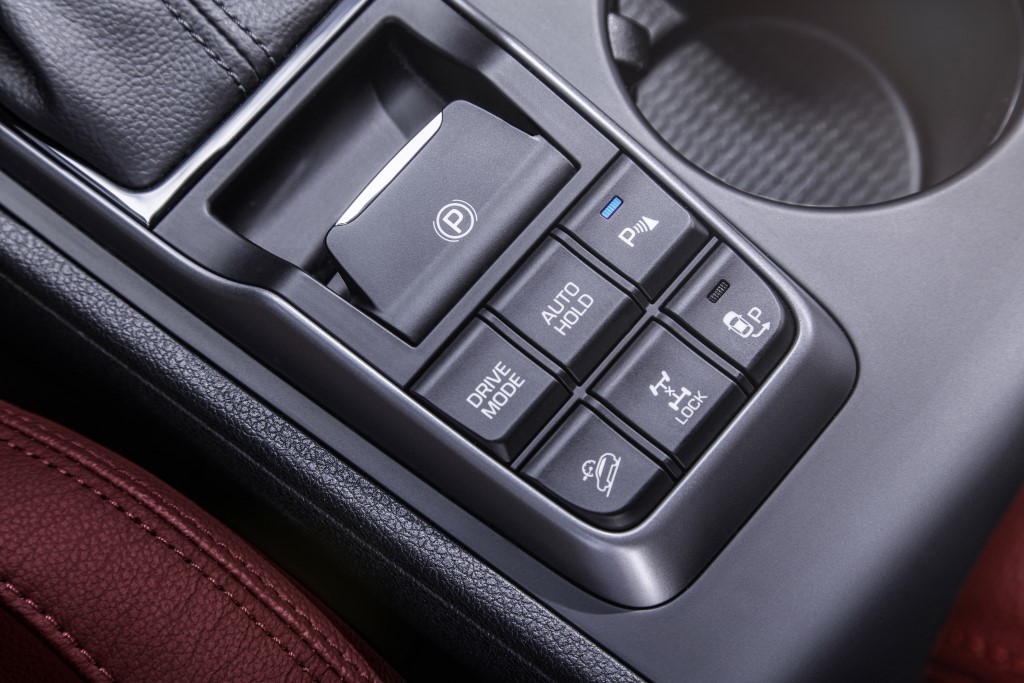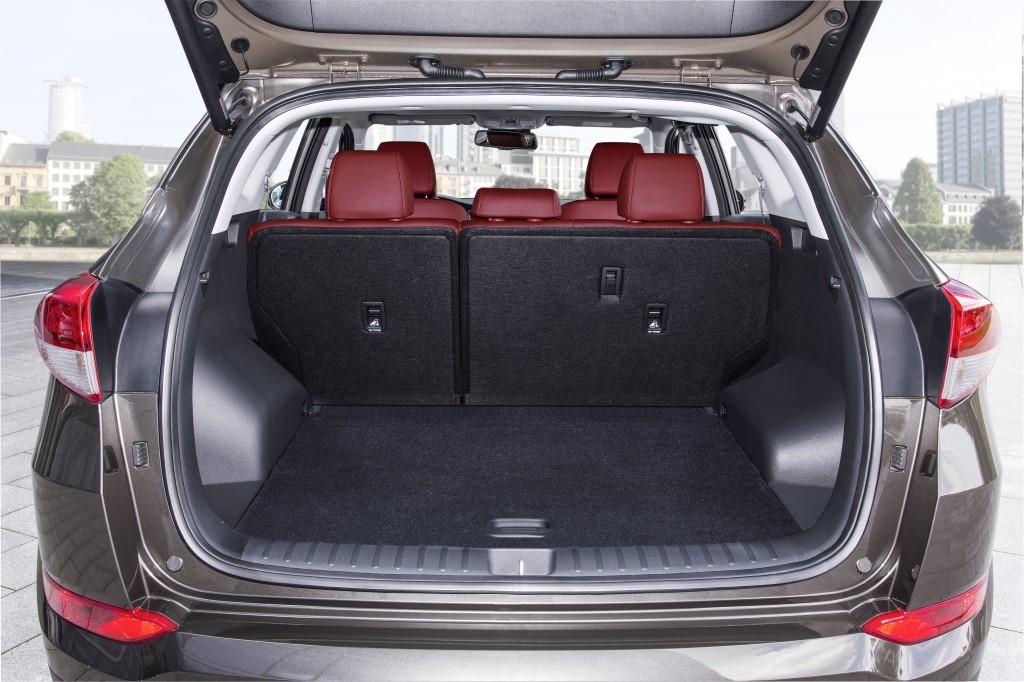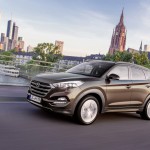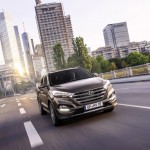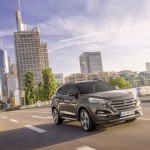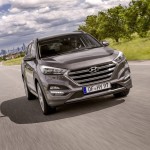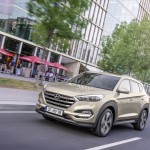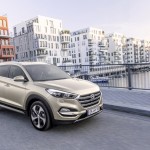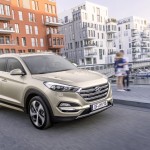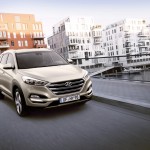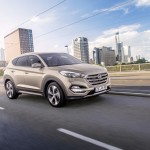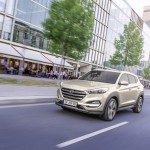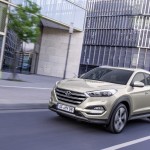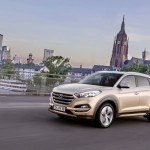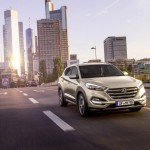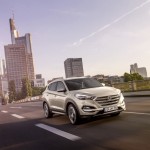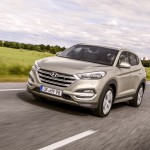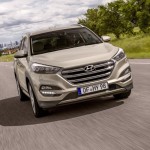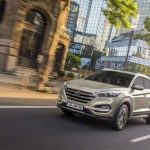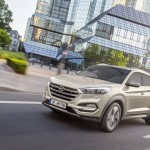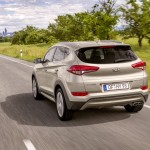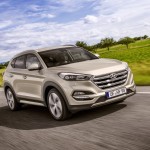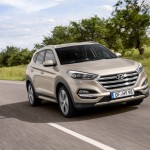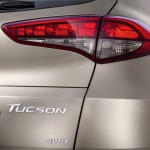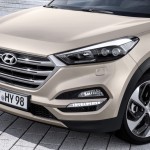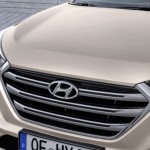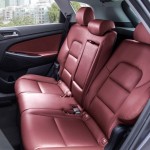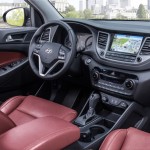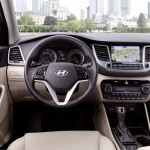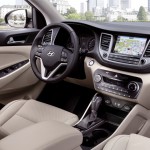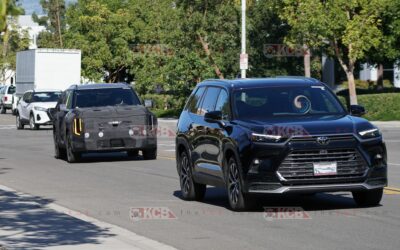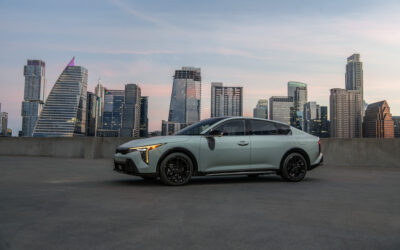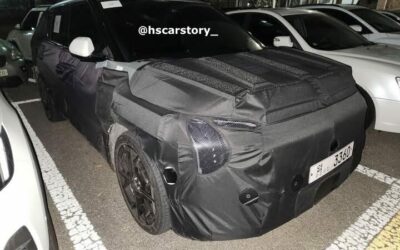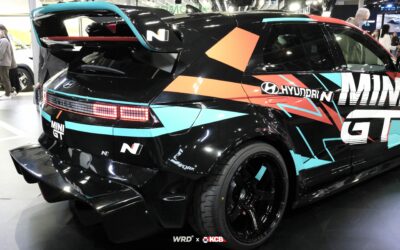We travelled to Frankfurt, where Hyundai Europe has its Headquarters to take a closer look on the 2016 Hyundai Tucson, a car that according to the the South Korean carmaker, is the new brand ambassador for Europe.
[ads id=”0″ style=”float:left;padding:9px;”]Peter Schreyer, President and Chief Design Officer at Hyundai Motor Group, explains how Hyundai designers achieved the dynamic proportions. “Design expresses our progressive spirit and passion, and it is transforming our brand. The All-New Tucson has a distinctive and athletic presence achieved through refined, flowing surfaces, bold proportions, sharp lines and most importantly, our newest generation hexagonal grille – our brand signature,” summarised Schreyer.
Exterior
The front of the 2016 Hyundai Tucson is dominated by the hexagonal grille, which connects with the LED headlamps to create a distinctive identity. A wing-shaped horizontal bar at the front bumper, which incorporates the LED daytime running lights, gives the car a unique style and provides a visual reference for the car’s wide track.
By moving the A-pillar back it becomes visually disconnected from the long bonnet, accentuating the sleek profile. The directional shape of the wheel arches contributes to the car’s agile and dynamic appearance, even at standstill. The expressive ‘Z’ character-lines above the rear wheel arches emphasise the powerful stance, while the kick-up belt moulding converges with the falling roof line to complete the sculptural side profile.
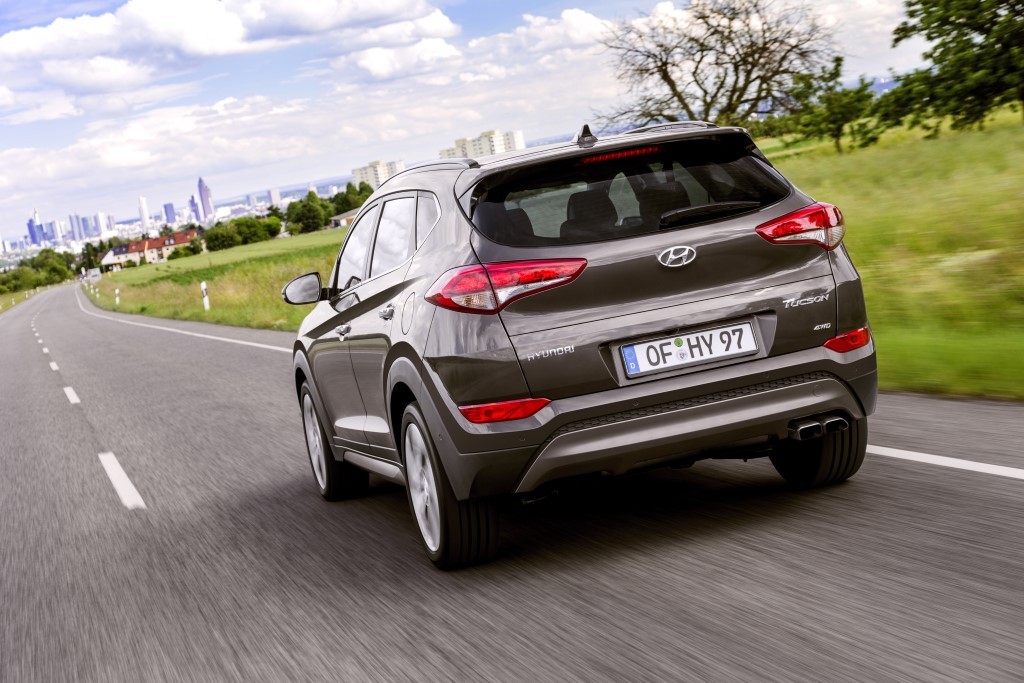
At the rear, the All-New Tucson’s personality is reinforced by strong horizontal lines flowing from the wheel arches. The combination lamps and reflectors are stretched to the body edges to further underline the bold proportions, with the rear skid plate and twin exhaust adding a sporty touch.
Refined interior combines elegance with ergonomics for a sensuous experience the Hyundai interior design team’s objective was to ensure that, when potential buyers first enter the car, they will be instinctively impressed by the cabin’s space and the attention paid to the smallest details.
Inside, new soft-touch, high-quality materials are introduced across the cabin surfaces, creating a refined cabin ambience.
The new horizontal layout of the centre console conveys the car’s elegance while increasing the feeling of roominess. The interior has undergone extensive ergonomic testing to ensure ease of use and a pleasant and sensuous experience.
Sophisticated exterior and interior colour palette
The 2016 Hyundai Tucson is offered with a distinguished range of 11 exterior colours, comprising one solid (Polar White), seven metallic (Ara Blue, Ash Blue, Micron Grey, Moon Rock, Thunder Grey, White Sand, Ultimate Red) and three pearl colours (Ruby Wine, Phantom Black, Platinum Silver).
[ads id=”0″ style=”float:left;padding:9px;”]Buyers have a choice of three sophisticated interior colours: Oceanids Black, Chai Beige and Red Wine. The Oceanids Black interior is available with cloth or high quality black leather upholstery. The elegant Chai Beige interior comes in a twotone layout with the lower dashboard in beige matching the cloth or leather upholstery. Adding further elegance to the interior is the exclusive Red Wine leather.
A number of clever convenience and connectivity features add refinement to the cabin and enhance the on-board experience. For increased interior comfort, customers can opt for heated seats and steering wheel. Unique to the segment, cooling seat ventilation is also available for the first
time. Front seats feature long seat cushions and can be ordered with eight-way power adjustment and two-way powered lumbar support for the driver sear. For rear-seat passengers, heated seats with reclining backrests are available, with practical air vents to increase comfort.
Generous space from efficient packaging
The All-New Tucson is built on a completely new platform that endows the C-SUV with generous interior dimensions. There is an excellent exterior-to-interior dimension ratio, continuing the Hyundai tradition for highly efficient packaging. With all seats upright, the roomy luggage area is 1,030 mm wide, 889 mm deep and 806 mm tall, delivering a substantial 513 litres (VDA 211) of capacity. This increases to a maximum of 1,503 litres with the rear seats folded. Practicality is boosted by a lower trunk-sill height, two-level trunk floor and a stowable cargo screen.
Convenience and connectivity features are tailored to customer needs the All-New Tucson includes a Smart Power Tailgate with the widest opening in the class. To ease loading, this opens as the key-holder approaches. Keyless-entry and engine start and an electronic parking brake offer added convenience. The intuitive Smart Parking Assist System (SPAS) can help with both parallel and bay parking. Using radar technology, the system identifies a free parking space before reversing the car into it, with only the brakes (with AT or 7DCT) or brakes and throttle (with
MT) operated by the driver. In addition, the exit mode function provides hands-free driver support when leaving a parking space.
The interior has been ergonomically designed to enable intuitive operation. The instrument cluster has been positioned towards the windscreen for excellent visibility and minimum distraction.
The A-pillar has been engineered to reduce blind-spot width by 6 mm compared to the previous model, with visibility from the lower side window increased by 37 mm. A panoramic sunroof adds to the airy feel, providing 30% wider opening than before. The centre console is fitted with a large, non-reflective 8-inch display screen for the new-generation navigation system, which is more than three times faster than the previous version. It also has more route options with quickly updated map material stored on an SD card. The new navigation system comes with a seven-year free subscription to TomTom LIVE services including TomTom traffic, Places, Speed Cameras and Weather.
The Navigation system can suggest the routes not only on the trip distance but also on the time needed to get to the final destination. TomTom Traffic provides the most accurate information about traffic jams, roadworks and delivers a trustworthy Estimated Time of Arrival (ETA). To help deal with unanticipated situations that require increased attention, the navigation system warns the driver when approaching a camera (fixed speed camera, mobile speed camera or traffic light) in countries where this is allowed
TomTom LIVE offers updated information in real time: weather, traffic, speed cameras, and online searches for points of interest with TomTom Places helping the driver to make better decisions that save time, reduce stress and improve road safety. A new seamless DAB+ digital radio with six audio speakers is also available. Further connectivity is provided through USB and AUX connections in the centre console.
Comprehensive active safety package The introduction of new technologies means the All-New Tucson is one of the most comprehensively equipped vehicles in its segment when it comes to safety features. Autonomous Emergency Braking (AEB) All-New Tucson is fitted with an Autonomous Emergency Braking system, this advanced active safety feature alerts drivers to unexpected emergency situations, braking autonomously if required. Using radar and camera sensors, the AEB system operates in three stages, initially warning the driver visually and acoustically, while gradually increasing the braking force.
If a potential crash is predicted, the system will apply the brakes automatically, with full braking force, to avoid or mitigate the collision. The activation range for pedestrian detection is up to 70 km/h, while other vehicles are detected up to 180 km/h. “Hyundai Motor aspires to deliver maximum value to customers by providing the highest levels of comfort- and safety-boosting technologies, without burdening vehicles with expensive, over-engineered equipment. Bringing sophisticated safety technology to the mass-market, the All-New Hyundai Tucson’s AEB system is capable of detecting preceding vehicles as well as pedestrians crossing the road, ” explained Werner Peter, Head of Electronics System Development at Hyundai Motor Europe Technical Center.
In addition, a Lane Keeping Assist System (LKAS) contributes to active safety by avoiding unintentional lane departures caused by driver distractions. The LKAS system warns the driver acoustically and visually before inducing a corrective steer force to guide the driver. The driver can choose three different modes in the instrument cluster: Lane Departure Warning, Standard LKA and Active LKA.
Also using radar technology, the Blind Spot Detector (BSD) with Lane Change Assist monitors the rear corners and, if another vehicle is detected, a visual alert appears on the exterior mirrors. If the driver then activates the indicators an audible signal is emitted. This also applies for a lane change situation when another vehicle is detected.
Using the BSD sensors the Rear-Cross Traffic Alert (RCTA) system reduces the risk of collision with approaching traffic when reversing out of narrow areas with low visibility. Using a radar to scan a 180-degree area behind the vehicle for approaching cross-traffic, RCTA alerts the driver visually and acoustically.
For added safety the Vehicle Stability Management (VSM) combines Electronic Stability Control (ESC) and Motor Driven Power Steering (MDPS) to help the driver keep the vehicle under control in case of an emergency maneuver. Under acceleration or braking on surfaces with different levels of grip, VSM applies selective steering forces to intuitively guide the driver to remain on course.
The Speed Limit Information Function (SLIF) uses the front camera and information from the navigation system to identify road speed signs and display the speed limit in real time. The information is displayed both in the navigation system display as well as in the TFT cluster.
New passive safety features for driver and pedestrian protection A number of passive safety features are included in the All-New Tucson. For
occupants there are six airbags, including driver, passenger, side and curtain airbags.
For pedestrian and cyclist safety, the Active Hood System raises the vehicle’s hood to cushion the impact shock in a frontal collision. Pyrotechnic actuators located in the bonnet hinges lift the hood around 60 mm in less than 20 milliseconds from the moment of impact. Bodyshell structure and use of ultra-high strength steel The all-new body shell structure features 51% ultra-high strength steel, increasing torsional rigidity (up by 48%) to offer greater impact resistance. Straightened body connections, applied on dash chassis member and A-pillar, provide additional collision energy dissipation paths. A new high-tensile steel side-impact protection device installed in the doors allows a more even distribution of impact forces.
The 2016 Hyundai Tucson is available with one of the widest powertrain ranges in its class. These include two gasoline engines: 132 PS (1.6-litre GDI) or 177 PS (1.6-litre T-GDI) – plus three diesel options: 115 PS (1.7-litre), 136 PS (2.0-litre standard power) or 185 PS (2.0-litre high power). The new turbocharged 1.6-litre T-GDI gasoline engine with 177 PS delivers maximum torque of 265 NM from 1,500 to 4,500 rpm and is offered with a six-speed manual or the seven-speed dual- clutch transmission (7DCT) which gives a choice of fully automatic operation or manual gear changes.
The 115 PS turbo-diesel engine delivers maximum torque of 280 Nm from 1,250 to 2,500 rpm and is available exclusively with a six-speed manual, 2WD and fuel-saving stop-start technology. The 2.0-litre turbo-diesel with a low inertia single-scroll turbocharger is offered in two versions. The ‘standard power’ 136 PS delivers 373 Nm of maximum torque at 1,500 – 2,500 rpm. The ‘high power’ 185 PS version delivers an impressive maximum torque of 400 Nm from 1,750 to 2,750 rpm. Both feature maintenance-free lean NOx trap catalyst technology to reduce emissions.
The seven-speed dual-clutch transmission (7DCT) is available for the first time in the Hyundai SUV line-up. Developed in-house, the7DCT system offers drivers fully automatic operation (ideal for town driving) or sequential manual gear changes, selected with the gear-lever for greater driver involvement. The new 7DCT system performs seamless shifting through an alternative operation of the two clutches, providing many benefits over an automatic transmission. For example, fuel consumption and CO2 emissions are reduced, and performance is enhanced while shifting quality is maintained.
This transmission features a high top gear ratio which lowers engine revs during high-speed cruising, enhancing refinement, while also improving fuel economy and cutting exhaust emissions. Compared to a six-speed automatic transmission, the fuel efficiency could be improved by up to 20%.
Four-wheel drive system The 1.6-litre T-GDI gasoline and 2.0-litre CRDi diesel engine can be mated with a fourwheel drive (4WD) system, which keeps the highest traction on rough, loose or slippery surfaces while enhancing cornering performance. The front wheels receive 100% of torque during normal road driving with up to 50% sent to the rear wheels, automatically, depending on conditions. A manually-selected ‘Lock Mode’ splits torque 50/50 for enhanced stability at speeds up to 40 km/h.
Integrated Stop & Go
All engines have been enhanced to offer improved driveability and fuel efficiency, as well as meeting Euro6 emission standards. Hyundai Motor’s efficient Integrated Stop & Go (ISG) system is standard for the 1.7-litre and the 2.0-litre diesel engines (Standard Power, MT/2WD) as well as the 1.6-litre gasoline engine.
New chassis for Europe focused on ride comfort and driving dynamics
The new chassis of the 2016 hyundai tucson has been developed for European customers with a focus on ride comfort without compromising driving dynamics. The new rackmounted motor-driven power steering is precise and direct while the new EU specific suspension and dampers offer high levels of comfort and compliance for a smooth ride.
The front suspension features a McPherson strut system, receiving a new rebound spring and four bush mountings on the subframe to enhance comfort and reduce NVH. The refined multilink rear suspension system is improved to enhance overall dynamics. As in the front, the rear subframe receives four bush mountings, while the upper and lower suspension arms are increased in length to enhance overall suspension performance.
Hyundai Motor has developed every element of the chassis to enhance high-speed and cornering stability, while also maximising the benefits of the long wheelbase (2670 mm) and wide track to optimise ride and handling characteristics for European roads and consumer needs. A brake system upgrade incorporates larger discs (305 mm front/ 302 mm rear) and wheel cylinders to enhance braking distance and heavy usage resistance.
A new electric motor-driven power steering (MDPS) system features newly developed software and a rack-mounted electric motor. Tuned for the European market, it affords a faster, more direct response to inputs, enabling the driver to feel more connected with the car and the road. Cornering performance is enhanced with Advanced Traction Cornering Control (ATCC), combining the 4WD variable torque distribution and ESC.
In the event of understeer, higher torque is applied to the rear axle, while braking the inner wheel, improving cornering performance. The new Drive Mode Select (DMS) function on automatic transmission models offers customers a choice of two drive modes – Normal and Sport – with different characteristics for the steering and transmission (for AT or 7DCT versions).
Comfortable and quiet cabin
The new, stiffer structure for the All-New Tucson has enabled Hyundai engineers to achieve significant gains in the suppression of noise, vibration and harshness (NVH), making it one of the quietest and most refined cabins in the class. Increased soundabsorption at the base of the A-, B- and C-pillars protects occupants from road vibrations, while new high-density anti-noise pads are fitted within the central and rear floor pans to limit noise ingress.
At the front an underfloor cover is fitted beneath the engine bay, while at the rear a change to bush-mounting rather than solid-mounting for the rear subframe isolates the cabin from road surface irregularities transferred through the rear suspension.
Tested on European roads
To ensure European customers receive the best possible combination of ride and comfort, handling and steering, performance and refinement, the All-New 2016 hyundai tucson was developed using Hyundai’s extensive engineering and testing facilities in Europe. Every element of the All-New Tucson’s running gear was tested to enhance highspeed and cornering stability, while also maximising the benefits of the longer wheelbase and wider track to optimise ride and handling characteristics for European roads.
Axel Honisch, Head of Vehicle Test and Development at Hyundai Motor Europe Technical Center, said: “We take a comprehensive approach to ensure that every Hyundai Motor vehicle is tested in the most extreme conditions so that our customers always enjoy high standards of comfort, ride, handling and reliability. To fully prepare the All-New 2016 hyundai tucson for the European market, our teams tested it in severe heat – from 40 degrees Celsius in southern Europe’s summertime down to 30 degrees below freezing in the Swedish winter.”
Hyundai engineers completed accelerated durability testing on the famous Nürburgring Nordschleife, supported by the company’s on-site test centre. Equivalent to 180,000 kilometres of everyday driving, the design concentrated on six key areas: steering, suspension, brakes, tyres, seats and air-conditioning, while evolving EU-specific adaptations of core hardware.

